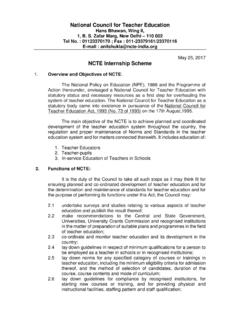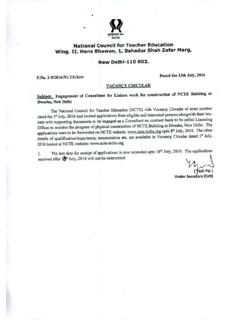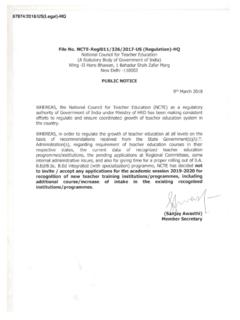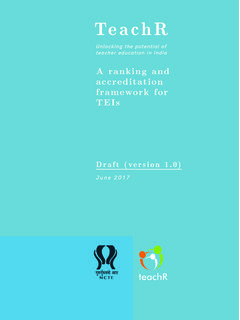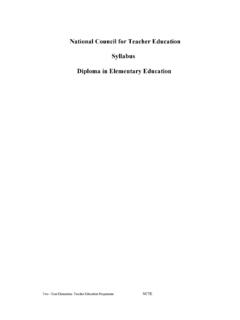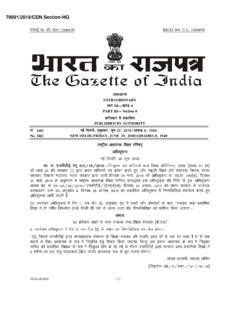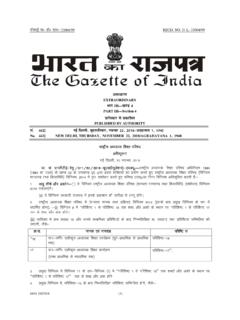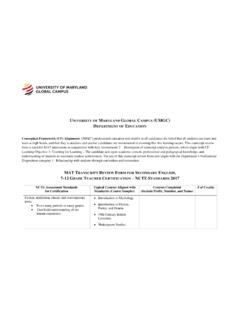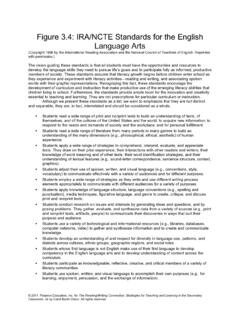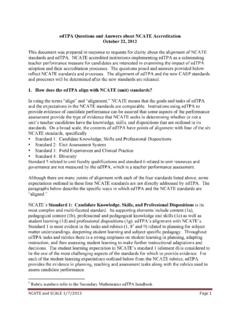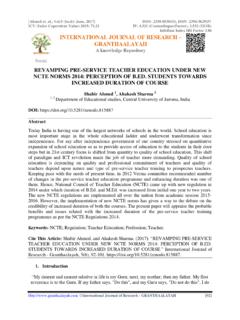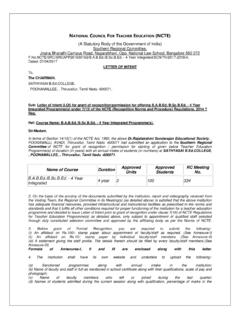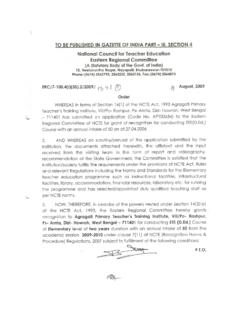Transcription of NCTE
1 ncte The National Council for Teacher Education ( ncte ) was established by an Act of Parliament (No. 73 of 1993) with a mandate to achieve planned and co-ordinated development of the teacher education through-out the country; for regulation and proper maintenance of norms and standards in the teacher education system; and for matter connected therewith. The ncte came into existence on 17th August, 1995. Programmes Recognised by ncte ncte notified revised Regulations and Norms and standards on November 28, 2014 for the following Teacher Education Programmes: 2-year diploma in early childhood education programme leading to Diploma in Preschool Education (DPSE). 2-year elementary teacher education programme leading to Diploma in Elementary Education ( ).
2 4-year bachelor of elementary teacher education programme leading to Bachelor of Elementary Education ( ) degree. 2-year bachelor of education programme leading to Bachelor of Education ( ) degree. 2-year master of education programme leading to Master of Education ( ) degree. 2-year diploma in physical education programme leading to Diploma in Physical Education ( ). 2-year bachelor of physical education programme leading to Bachelor of Physical Education ( ) degree. 2-year master of physical education programme leading to Master of Physical Education ( ) degree. 2-year diploma in elementary education programme through Open and Distance Learning System leading to Diploma in Elementary Education ( ). 2-year bachelor of education programme through Open and Distance Learning System leading to Bachelor of Education ( ) degree.
3 2-year diploma in arts education (Visual Arts) programme leading to Diploma in Arts Education (Visual Arts). 2-year diploma in arts education (Performing Arts) programme leading to Diploma in Arts Education (Performing Arts). 4-year integrated programme leading to (Integrated) degree. Bachelor of education programme 3-year (Part Time) leading to Bachelor of Education ( ) degree. 3-year integrated programme leading to (Integrated) degree. National Council for Teacher Education (A Statutory Body of the Government of India) Yoga Education (Bachelor of Education) UNIT 1 Introduction to Yoga and Yogic Practices 11 UNIT 2 Introduction to Yogic Texts 43 UNIT 3 Yoga and Health 65 UNIT 4 Guidelines for Practicum 91 2 Yoga Education YOGA EDUCATION (BACHELOR OF EDUCATION ) [ISBN: 978-81-931534-1-3] EXPERT ADVISORY COMMITTEE Prof.
4 Nagendra, Chancellor, SVYASA University, Bangalore (Chairperson) Swami Atmapriyananda, Vice Chancellor, Rama Krishna Mission Vivekananda University, West Bengal Prof. Sharma, HOD, Department of Yoga Science, Patanjali Yogapeeth, Haridwar Dr. Swami Mangalteertham, Bihar School of Yoga, Munger, Bihar Shri Tiwari, Secretary, Kaivalya Dham, Lonavala, SMYM Samiti, Pune Dr. Ishwar V. Basavaraddi, Director, Morarji Desai National Institute of Yoga, New Delhi Dr. Rajvi H. Mehta, Chief Secretary, Iyengar Yogashraya, Lower Parel, Mumbai Dr. Chinmaya Pandya, Pro-Vice Chancellor, Dev Sanskriti Vishwavidyalaya, Haridwar PROGRAMME DEVELOPMENT Prof. Santosh Panda, Chairperson, National Council for Teacher Education, New Delhi (Project Director) Prof. Dagar (Retd.), University, Rohtak, Haryana (Project Coordinator) WRITER Dr.
5 Bhogal, Kaivalya Dham, Lonavala, SMYM Samiti, Pune (Units 2-4) Ms Karuna Nagarajan, S-Vyasa University, Bangalore (Units 1, 3) EDITORS Dr. Ishwar V. Basavaraddi, Director, Morarji Desai National Institute of Yoga, New Delhi Prof. Dagar (Retd.), University, Rohtak, Haryana Dr. Sadhana Arya, Guest faculty, MDNIY COPY EDITING Prof. Dagar (Retd.), University, Rohtak, Haryana PRINT PRODUCTION Dr. Rakesh Tomar, Under Secretary (Academic), ncte , New Delhi Shri Piyush, Malviya Nagar, New Delhi (Designer) SECRETARIAL ASSISTANCE Smt. Kanika Dhillon, Personal Assistant, ncte , New Delhi Shri Umesh Kumar, Personal Assistant, ncte , New Delhi June 2015, National Council for Teacher Education, New Delhi. ISBN: 978-81-931534-1-3 All rights reserved. No part of this work may be reproduced in any form by mimeograph or any other means, without permission in writing from National Council for Teacher Education, New Delhi.
6 Published by Shri Juglal Singh, Member Secretary, ncte , on behalf of the ncte . Further information about the ncte can be obtained from ncte office at Hans Bhawan, Wing II, 1 Bahadurshah Zafar Marg, New Delhi-110002, India. Website: Cover Design: Shri K. Vishvanathan, New Delhi Printed at: St. Joseph Press, New Delhi Price: Rs. 400/- (Student Edition: Rs. 200/-) Bachelor of Education 3 Contents Page 4 5 7 About the 8 Module description Module objectives Units in the module Unit 1: Introduction to Yoga and Yogic 11-42 Introduction Learning objectives Yoga: meaning and initiation Origin and history of development of Yoga A ga Yoga or R ja Yoga The streams of Yoga The schools of Yoga: R ja Yoga and Ha ha Yoga Yogic practices for healthy living Some select yogic practices Summary Unit-end questions/exercises Unit 2.
7 Introduction to Yogic 43-64 Introduction Learning objectives Historicity of Yoga as a discipline Classification of Yoga and yogic texts Understanding A ga Yoga of Pata jali Ha ha yogic practices Complementarily between P ta jala Yoga and Ha ha Yoga Meditational processes in P ta jala Yoga S tra Summary Unit-end questions/exercises Unit 3: Yoga and 65-90 Introduction Learning objectives Need of Yoga for positive health Role of mind in positive health as per ancient yogic literature Concept of health, healing and disease: yogic perspectives Potential cause of ill health Yogic principles of healthy living Integrated approach of Yoga for management of health Stress management through Yoga and yogic dietary considerations Summary Unit-end questions/exercises Unit 4: Guidelines for 91-118 Introduction Learning objectives General guidelines for performance of the practice of Yoga for the beginners Select Yoga practices for persons of average health for practical Yoga sessions Summary Unit-end questions/exercises 4 Yoga Education Guidelines for Internship.
8 119 120 122 Questions for 123 Suggestive Answers to 124 Bachelor of Education 5 Foreword The role of teachers as agents of change promoting understanding and tolerance, and improving the quality of education of children cannot be over-emphasized. It necessitates demand for teachers who are professionally competent, responsible, and responsive to the needs of society; who are enthused with motivation, appropriate knowledge and skills; and who display a positive attitude towards life and other people; teachers who have personal characteristics of integrity and a kind of spiritual orientation. What is most needed is to transform the personality, especially the attitudes, of our teachers and teacher educators in a direction that would facilitate appropriate development of personality and attitude of children and young adults for healthy and peaceful living, and for effectively contributing to social and national development, and global understanding.
9 This also involves development of domain-specific knowledge and competencies and social/life skills in teachers and teacher educators. It is for this and allied reasons that the ncte ventured into revamping the teacher-education curricula and syllabi at different levels of teacher education, and introduced Yoga Education as a compulsory area of study in all teacher education programmes in the country. The ncte s role in this regard is simply laudable, for Yoga is a scientifically proven/verifiable system of providing excellence to the development of a total human personality; and this can be a panacea for most human ills and misfortunes both physical and mental. The techniques of yogic science, if regularly and properly practised, can relieve us of the stress and anxiety, dread and fear, anguish and frustrations, which, if persist for long, can result in developing various psychosomatic disorders that people today suffer from.
10 There are also other spiritual dimensions to this life style. The three modules prepared by the ncte on Yoga Education for , and are intended to fulfill the great expectations that the society has placed on teachers and teacher educators in respect of development of composite personality in teacher educators and teachers, and in turn in the students. I, on behalf of ncte , thank the Expert Advisory Committee (and specially Guruji Nagendra, the chair of the Committee), the writers, the editors, other staff involved in this, Prof Bhim Singh Dagar (coordinator of this project), and Shri Juglal Singh, Member Secretary, ncte for achieving this target on time. New Delhi Santosh Panda June 8, 2015 Chairperson6 Yoga Education Preface The education of teachers is paramount to improving the quality of education of children, since teachers are instrumental in developing in children positive attitudes, stimulate curiosity, awaken their creative potential, promote understanding and tolerance, helping children understand themselves and the environment they live in, and eventually develop in them the moral consciousness, sensitivity and responsiveness to the needs of society.
